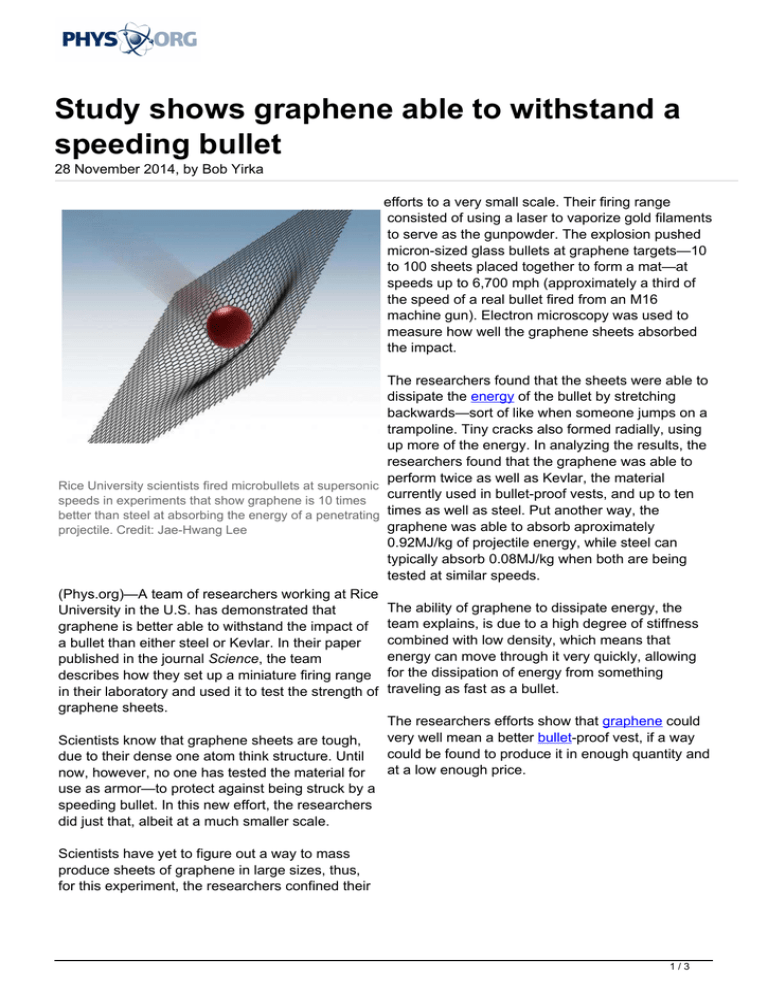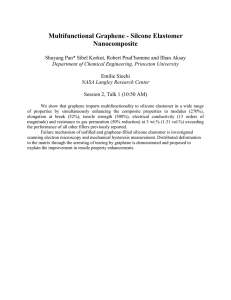Study shows graphene able to withstand a speeding bullet
advertisement

Study shows graphene able to withstand a speeding bullet 28 November 2014, by Bob Yirka efforts to a very small scale. Their firing range consisted of using a laser to vaporize gold filaments to serve as the gunpowder. The explosion pushed micron-sized glass bullets at graphene targets—10 to 100 sheets placed together to form a mat—at speeds up to 6,700 mph (approximately a third of the speed of a real bullet fired from an M16 machine gun). Electron microscopy was used to measure how well the graphene sheets absorbed the impact. The researchers found that the sheets were able to dissipate the energy of the bullet by stretching backwards—sort of like when someone jumps on a trampoline. Tiny cracks also formed radially, using up more of the energy. In analyzing the results, the researchers found that the graphene was able to perform twice as well as Kevlar, the material Rice University scientists fired microbullets at supersonic currently used in bullet-proof vests, and up to ten speeds in experiments that show graphene is 10 times better than steel at absorbing the energy of a penetrating times as well as steel. Put another way, the graphene was able to absorb aproximately projectile. Credit: Jae-Hwang Lee 0.92MJ/kg of projectile energy, while steel can typically absorb 0.08MJ/kg when both are being tested at similar speeds. (Phys.org)—A team of researchers working at Rice The ability of graphene to dissipate energy, the University in the U.S. has demonstrated that graphene is better able to withstand the impact of team explains, is due to a high degree of stiffness combined with low density, which means that a bullet than either steel or Kevlar. In their paper energy can move through it very quickly, allowing published in the journal Science, the team describes how they set up a miniature firing range for the dissipation of energy from something in their laboratory and used it to test the strength of traveling as fast as a bullet. graphene sheets. The researchers efforts show that graphene could very well mean a better bullet-proof vest, if a way Scientists know that graphene sheets are tough, could be found to produce it in enough quantity and due to their dense one atom think structure. Until at a low enough price. now, however, no one has tested the material for use as armor—to protect against being struck by a speeding bullet. In this new effort, the researchers did just that, albeit at a much smaller scale. Scientists have yet to figure out a way to mass produce sheets of graphene in large sizes, thus, for this experiment, the researchers confined their 1/3 More information: Dynamic mechanical behavior of multilayer graphene via supersonic projectile penetration, Science 28 November 2014: Vol. 346 no. 6213 pp. 1092-1096. DOI: 10.1126/science.1258544 A microbullet traveling at supersonic speed is captured in this composite of three timed images as it makes its way toward a suspended sheet of multilayer graphene. Experiments carried out at Rice University show graphene is 10 times better than steel at absorbing the energy of a penetrating projectile. The bubble at left is a polymer film expanding away from the gold substrate that transfers energy from a laser to the microbullet. Credit: Thomas Research Group/Rice University ABSTRACT Multilayer graphene is an exceptional anisotropic material due to its layered structure composed of two-dimensional carbon lattices. Although the intrinsic mechanical properties of graphene have been investigated at quasi-static conditions, its behavior under extreme dynamic conditions has not yet been studied. We report the high–strain-rate behavior of multilayer graphene over a range of thicknesses from 10 to 100 nanometers by using miniaturized ballistic tests. Tensile stretching of the membrane into a cone shape is followed by initiation of radial cracks that approximately follow crystallographic directions and extend outward well beyond the impact area. The specific penetration energy for multilayer graphene is ~10 times more than literature values for macroscopic steel sheets at 600 meters per second. Press release © 2014 Tech Xplore Materials scientist Edwin "Ned" Thomas, left, dean of the George R. Brown School of Engineering at Rice University, and Jae-Hwang Lee, a former postdoctoral researcher in his lab and now an assistant professor at the University of Massachusetts, Amherst, found graphene is stronger than steel in tests with microbullets. The researchers hold a polymer encasing bullets, the focus of a previous experiment. Credit: Tommy LaVergne/Rice University 2/3 APA citation: Study shows graphene able to withstand a speeding bullet (2014, November 28) retrieved 30 September 2016 from http://phys.org/news/2014-11-graphene-bullet.html This document is subject to copyright. Apart from any fair dealing for the purpose of private study or research, no part may be reproduced without the written permission. The content is provided for information purposes only. 3/3 Powered by TCPDF (www.tcpdf.org)




